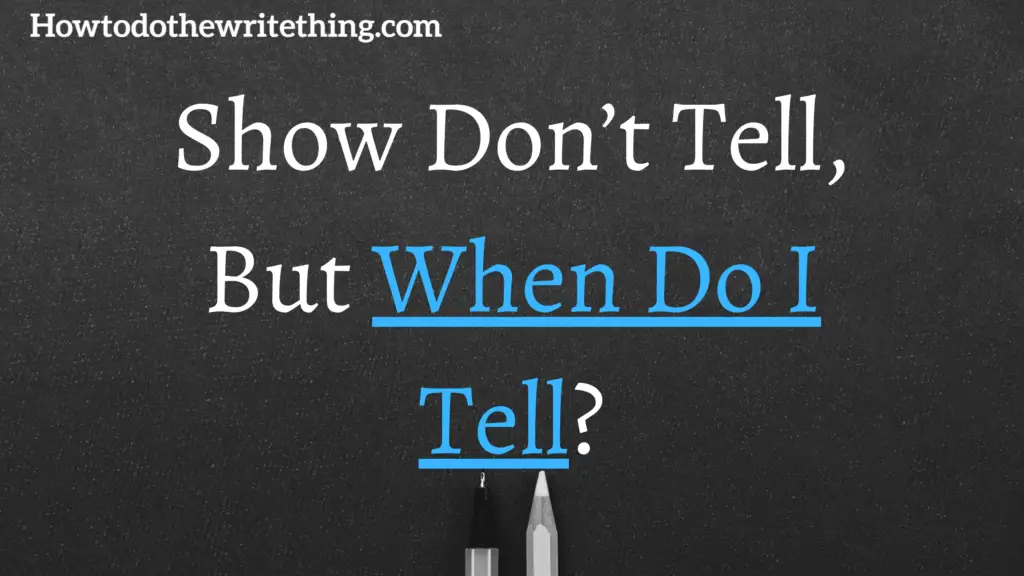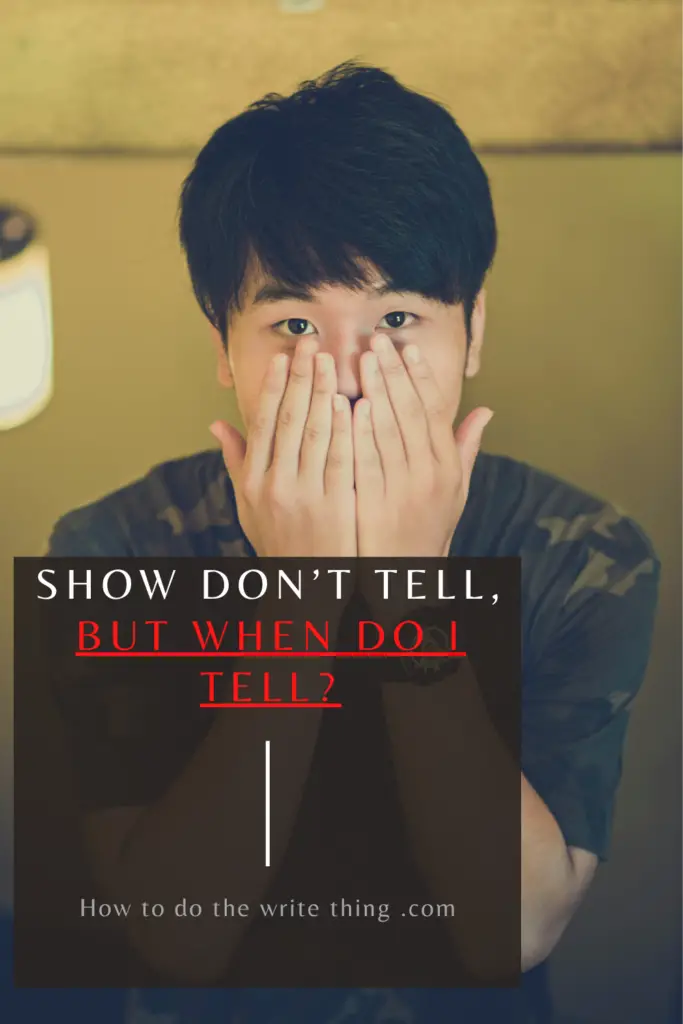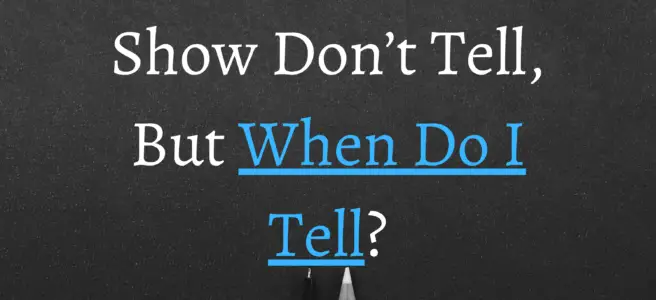
Show Don’t Tell, But When Do I Tell?
Show Don’t Tell, But When Do I Tell?
Show don’t tell is one of the most prominent cliches of writing advice.
If it’s a cliché, why does it keep flying around so much?
As with most clichés it sticks around and passes the test of time because it is powerful advice.
But when do we disobey this advice.
Aren’t there times in our writing when we tell instead of showing? Or is that unnecessary.
We believe it’s necessary to tell sometimes and we’re going to talk about when to tell not show.
1. Backstory Dialogue
Many times it will benefit us to have our character tell the backstory of an event, place, or person.
This is a moment where you mostly would tell not show.
Have you ever had a friend tell you a story?
It would be very similar to that.
They wouldn’t say, “and then the moonlight glistened off the glass as she ran away as fast as she could.
They would say things like, “Did you hear about Sharon?”
“No, what happened?”
“Well I heard the other night that she threw a baseball bat through her window in the middle of the night and ran away!”
“Ran away? Where did she go?”
“I don’t know! But nobody has seen her in a couple days.”
This is a perfect tell don’t show moment. In this way you can relay information from one character to another and to your reader without showing them the scene your character just described.
It would be absurd if your character started talking as if they were a narrator in a play or an author describing a scene. Instead they just tell events as they were told themselves. In a normal way.
2. Give it Less Priority
Telling something can give it less priority depending on what it is.
“Kelly grabbed the window sill with her right hand. She winced, cutting it on some broken glass. She carefully lifted her legs one after the other over the broken mess and placed her feet on the porch. More broken glass found her there but she kept moving forward until she could start to run.”
Or,
“Kelly cut her hand as she jumped out the window and started to run. The night was cold, but she didn’t even notice. She has no idea where she was going but she knew exactly where she was never going again. Back. Back there. It felt good. She felt free. She felt like her world was finally a blank page that she herself could write and it was the most beautiful thing she had ever known.”
Both of these scenarios are fine. They both do the job of showing our reader an important moment but each emphasizes something different.
One emphasizes description by showing the reader what’s going on as if they were watching it themselves.
The other doesn’t emphasize that moment to the reader but just glosses over it by telling it to them and instead emphasizes the characters thoughts, feelings, and emotions.
There doesn’t seem to be a wrong way here, just choosing what you want to be swirling around in the mind of your reader.
3. Whether You or Your Character is the Narrator
If you the author are the narrator, then you might do a-lot of showing as you narrate certain parts of the plot to the reader.
If on the other hand you’ve decided to tell the story from your character’s point of view then your character’s telling will emphasize a part of their personality.
You might say, “Kelly didn’t know it then but this was the worst decision she had made in her entire life. The road ahead was full of much turmoil and anguish.
If she had stayed she would have suffered too, but not as much as she was about to.
Or if your character narrated their own story,
“I don’t know it then, but that was the worst decision I ever made in my life. If I could go back, I wouldn’t have ran away that night. Maybe two or three days later, but not that night.”
Again both work, but it’s up to you how you want the feel of your story to be.
4. Some Action Should be Told Not Shown
Some actions are better told not shown. If we have a scene that has a lot of action the scene of self might get bogged down if we try to describe it all.
“As Kelly ran through the woods the wind was blowing enough to keep the leaves rustling. Sweat gleamed down her face as she never stopped. The moonlight was the only way she could where she was going and she ran deeper and deeper into more woods and brush. Thorns and thistles grabbed her skin on her legs and blood trickled down unnoticed by her.”
This is too much showing in my opinion. What we’re showing is not that important to moving the story forward and it doesn’t give the reader any extra enjoyment. It’s just extra filler, and almost pointless extra description.
You’d be better off to condense moments by telling more and showing less at the right times.
“Kelly ran for at least thirty minutes before she even started to think about where she was going. She finally noticed how windy and cold it was. She, for the first time, thought about extra food and clothing. Should she go back, grab some things quickly and then get out again? No. She kept running. Even though there was enough moonlight to see she still got scrapes and cuts from random brush. She looked like a tattered mess by the time she reached the first abandoned highway.”
Instead of over describing this part of Kelly’s story we create some more emotional thoughts and feelings so the reader can continue to get to know our character. We set up the way she looks just by telling our reader and we continue to move the story along.
Don’t waste words. Either be entertaining or moving the story along. You’re better off to try to always do both simultaneously.
Show Don’t Tell, But When Do I Tell?
Enjoying Show Don’t Tell, But When Do I Tell? Take a moment and consider sharing this social-friendly image to say thanks and feel free to comment with your thoughts below! 🙂

Show Don’t Tell, But When Do I Tell?
A break from Show Don’t Tell, But When Do I Tell? to see if these affiliate offers might help you make more money with blogging.
Need a Cheaper Plan? Try DreamHost.
If you enjoy Show Don’t Tell, But When Do I Tell, storytelling, and creating content in general, you might love owning a domain of your own where you can write about it? Ever want to own your own domain name (Yourname.com)?
Bluehost hosts your blog so that you can own your domain and make money blogging. Check them out only if you’re interested in making money blogging; otherwise, go for a free blog instead 🙂
Try Grammarly, The Free tool that should be in every writer’s toolbelt.
Show Don’t Tell, But When Do I Tell?
Check this out.
Or
Now back to the show: Show Don’t Tell, But When Do I Tell?
5. Move the Story Forward
We covered this in point 4 but it’s so important.
Don’t waste your reader’s time describing actions and scenes just for the sake of dramatic description.
If it makes the story better, if it makes sense, then describe more.
If you just want the satisfaction of describing it, you should question whether it’s important or not and consider just taking it.
6. Transition Moments
Point 4 is a good example of over description versus a good translational moment.
We could paint the picture of the woods, the sweat, the blood. ( all good things to describe at the right moments) Or we can tell them what’s happening and get them to the next part of our story “the abandoned highway.” (Even sounds like a chapter title.)
Which does the reader more service? Do we send them better by telling them all about the stuff that doesn’t matter to the story or do we serve them better by telling them some stuff that’s important and getting them to the next part that matters.
You might even say, by getting them to the next part that they actually care about.
When deciding what to shore out what to tell, ask yourself which is going to best serve the reader in this moment.
7. What are You Going to Bring Back Up?
Someone’s showing something to your reader instead of telling them is a good way to bring your reader’s attention to an important fact or object that you will bring up again later in the story.
This type of writing is clever and readers love it.
For instance what if something important fell out of Kelly’s pocket? We could create a nice hook if we describe it but don’t tell the reader exactly what it is yet.
“As Kelly ran, she didn’t notice but something slipped out of her pocket. It fluttered to the moist grass and tumbled away in the wind. If Kelly had turned back she might have seen it.”
Now we have something we’ve used “showing” to point out to the reader and they are now looking forward to finding out what it is.
You could also do this just by “telling.” And it might be even better that way.
“As Kelly was running, something fell out of her pocket. It was something very important. If she had known she had lost this she probably would have turned back that very night.”
No description, just telling and it may be more fitting for the moment. You can decide which you like better.
8. Telling Emotion
Sometimes it’s better to tell emotion rather than show it.
“Kelly finally stopped. She bent over with her hands on her legs and just breathed. Tears started rolling down her cheeks. She fell to her knees as tears flooded down her face. She sobbed until no more tears would surface. She looked up at the moon and it now glistened in her broken eyes.”
Or,
“Kelly finally stopped. She bent over with her hands on her knees and just breathed. Before she could help it tears started streaming down her face. She cried. Then she started to sob. She collapsed to her knees and just sobbed until she couldn’t anymore.
She felt empty and exhausted. She wanted someone, anyone to hold her and tell her it was over and everything was going to be alright now. She walked home. A place where she could find comfort and rest. A place where she could close her eyes without fear of creaking wood and footsteps approaching her.”
So instead of describing more of the scene take certain moments to tell more about your character and the thoughts and emotions they’re feeling.
Give your reader a reason to connect with them on another level. One that makes them actually care what happens to the character next.
Hope this helps!
Happy writing!
Another Post you Might like:
Mythical Creatures | 7 Tips on How to Write Mythical Creatures
Other Popular Posts you might enjoy:
5 Tricks How to Hide Your Villain Right Before Their Eyes
10 Tips How to Write Villains that Play Mind Games with Their Victims
4 Tips How to Write your Character Hitting Rock Bottom
10 Toxic Bad Habits That’ll Crush Your Fictional Character’s Relationships
How to Write From Your Villain’s Mind.
How To Write 4 Scenes That Reveal Who Your Character Is Seamlessly
Psychopath: How to Write The Perfect Psychopath
8 Tips How to Write the Perfect Sociopath
Fictional Characters: 28+ Bad Habits to Introduce to Your Fictional Characters
List of 10 Weapons for Fictional Characters
List of 10 Bad Habits Fictional Characters Need Help Breaking
Resources:
How to Start a Blog in 11 Simple Easy Steps in 2020
How to Write a Book: 32 Tips | Your MASSIVE Guide How to Write a Book
Define Self-Esteem for Writing Characters: 10 Ideas
Covert Narcissist and Why You Should Write One
Inspiring Quotes Posts:
Inspiring Quotes | 101+ Inspirational Quotes to Motivate You Today
190+ Inspirational Quotes for Women
303+ Funny Inspirational Quotes
115+ Inspirational Quotes in Short
103+ Quotes About What is Love
This post:
Show Don’t Tell, But When Do I Tell?
A break from Show Don’t Tell, But When Do I Tell? to see if these affiliate offers might help you make more money with blogging.
Need a Cheaper Plan? Try DreamHost.
If you enjoy Show Don’t Tell, But When Do I Tell, storytelling, and creating content in general, you might love owning a domain of your own where you can write about it? Ever want to own your own domain name (Yourname.com)?
Bluehost hosts your blog so that you can own your domain and make money blogging. Check them out only if you’re interested in making money blogging; otherwise, go for a free blog instead 🙂
Try Grammarly, The Free tool that should be in every writer’s toolbelt.
Show Don’t Tell, But When Do I Tell?
Check this out.
Or
Now back to the show: Show Don’t Tell, But When Do I Tell?
Show Don’t Tell, But When Do I Tell?
Enjoying Show Don’t Tell, But When Do I Tell? Take a moment and consider sharing this social-friendly image to say thanks and feel free to comment with your thoughts below! 🙂

Show Don’t Tell, But When Do I Tell?
A break from Show Don’t Tell, But When Do I Tell? to see if these affiliate offers might help you make more money with blogging.
Need a Cheaper Plan? Try DreamHost.
If you enjoy Show Don’t Tell, But When Do I Tell, storytelling, and creating content in general, you might love owning a domain of your own where you can write about it? Ever want to own your own domain name (Yourname.com)?
Bluehost hosts your blog so that you can own your domain and make money blogging. Check them out only if you’re interested in making money blogging; otherwise, go for a free blog instead 🙂
Try Grammarly, The Free tool that should be in every writer’s toolbelt.
Show Don’t Tell, But When Do I Tell?
Check this out.
Or
Now back to the show: Show Don’t Tell, But When Do I Tell?
Make sure your posts are readable. Use this readability score check
Want to check out a writer’s community to test your writing and get feedback?
Check out these FREE trial resources from Amazon for when you work from home (or are stuck at home 🙂 ) As an Amazon associate, if you do sign up or buy anything using Amazon links from our site we make a commission at no extra cost to you.
Free Prime Membership Trial:
Try Amazon Prime 30-Day Free Trial
Try Prime Discounted (Free Trial)
Make your Free Amazon Wedding Registry:
Create an Amazon Wedding Registry
Get Free Video Channels Trial with Prime:
Join Prime Video Channels Free Trial
Try a Free Amazon Family Trial:
Join Amazon Family (30-day Free Trial)
Get Unlimited Music for Free (30-day free trial):
Free movies and TV shows trial:
Join Amazon Prime – Watch Thousands of Movies & TV Shows Anytime – Start Free Trial Now
Free Prime for students trial:
Free Baby Registry:
Shop Amazon – Create an Amazon Baby Registry
Free trial of Twitch Prime:
Show Don’t Tell, But When Do I Tell?
And for when you REALLY work at home:
Create Amazon Business Account
It is the Amazon you love, for work. Make workplace procurement easier with convenient delivery options, simplified purchasing workflows, multiple payment options, and a competitive marketplace with business-only pricing and quantity discounts. Anyone who makes purchases for work (eg. procurement specialists, office administration, IT departments, etc.) can create a FREE account for their business. Customer must be from a verified business in order to successfully create their Amazon Business account.
Show Don’t Tell, But When Do I Tell?
We hope you enjoyed: Show Don’t Tell, But When Do I Tell?




